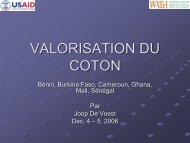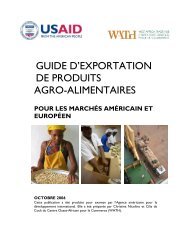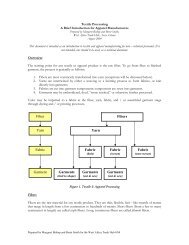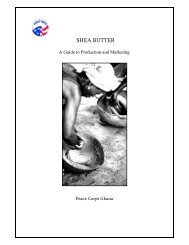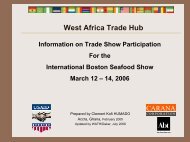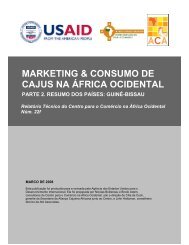A Value Chain Analysis of the Cashew Sector - AGOA Export Toolkit
A Value Chain Analysis of the Cashew Sector - AGOA Export Toolkit
A Value Chain Analysis of the Cashew Sector - AGOA Export Toolkit
You also want an ePaper? Increase the reach of your titles
YUMPU automatically turns print PDFs into web optimized ePapers that Google loves.
2 The value chain analysis<br />
2.1 Historical Background <strong>of</strong> <strong>Cashew</strong> Farming in Ghana<br />
In <strong>the</strong> early 1990’s Ghana embarked on an Economic Recovery<br />
Programme (ERP), which helped rekindle interest in cashew<br />
production. Making this a viable export crop was considered<br />
one way <strong>of</strong> broadening and diversifying <strong>the</strong> country’s export<br />
base. Th e implementation <strong>of</strong> <strong>the</strong> ERP resulted in <strong>the</strong> liberalisation<br />
<strong>of</strong> commodity markets. <strong>Cashew</strong> farmers gained access<br />
to marketing centres and benefi ted from prompt payment for<br />
<strong>the</strong>ir nuts. Farmers became enthusiastic about <strong>the</strong> crop and<br />
invested money and labour to rehabilitate some <strong>of</strong> <strong>the</strong> old<br />
cashew farms that had been planted in <strong>the</strong> late 1980’s under<br />
<strong>the</strong> National Agr<strong>of</strong>orestry Programme. As a result, Ghana recorded<br />
its fi rst RCN export <strong>of</strong> 50 t in 1991. By 1997, according<br />
to <strong>of</strong>fi cial statistics, cashew exports had increased to 3,571 t.<br />
In 1998, <strong>the</strong> Ministry <strong>of</strong> Food and Agriculture commissioned<br />
and funded a study on <strong>the</strong> status <strong>of</strong> <strong>the</strong> cashew industry. Th is<br />
focused, in particular, on its performance, <strong>the</strong> potential for<br />
production, possible areas for cultivation, as well as <strong>the</strong> general<br />
problems hindering <strong>the</strong> industry in its development. One <strong>of</strong><br />
<strong>the</strong> conclusions <strong>of</strong> this study is that <strong>the</strong>re is potential to increase<br />
<strong>the</strong> area under cultivation. It is estimated that more than 3 million<br />
ha <strong>of</strong> land suitable for cultivating cashew are available,<br />
largely in <strong>the</strong> Nor<strong>the</strong>rn and Brong-Ahafo regions. However,<br />
this estimate should be treated with caution, given <strong>the</strong> competing<br />
uses for land and related environmental aspects. None<strong>the</strong>less,<br />
this study also indicated that increased cashew production<br />
in Ghana has a tremendous potential for raising signifi cantly<br />
<strong>the</strong> income <strong>of</strong> rural farm families, and hence for reducing rural<br />
poverty.<br />
Table 2.1 Estimated Potential Areas for <strong>Cashew</strong> Cultivation in Ghana<br />
Major Areas <strong>of</strong> Production Potential Area (ha)<br />
Coastal Savanna 21,000<br />
Brong-Ahafo/Afram Plains 1,150,000<br />
Upper East Region 220,000<br />
Nor<strong>the</strong>rn Region 1,180,000<br />
Upper West Region 510,000<br />
TOTAL 3,270,000<br />
Source: Addaquay and Nyamekye-Boamah (1998), as cited by SNV (2006/07)<br />
In 2003, <strong>the</strong> Government <strong>of</strong> Ghana (GoG) requested <strong>the</strong> African<br />
Development Bank (AfDB) to fi nance a six-year <strong>Cashew</strong><br />
Development Project (CDP) in fi ve regions at a cost <strong>of</strong> US$<br />
13.32 million. Th e CDP aimed to increase production by<br />
doubling <strong>the</strong> <strong>the</strong>n 18,000 ha under cultivation, and to expand<br />
<strong>the</strong> processing <strong>of</strong> cashews at <strong>the</strong> village level. Th e CDP<br />
facilitated an integrated and coordinated approach towards<br />
<strong>the</strong> development <strong>of</strong> <strong>the</strong> cashew industry. Up until <strong>the</strong>n, only<br />
a few isolated attempts had been made by individuals, government<br />
agencies, and NGOs to promote <strong>the</strong> cashew sector<br />
in Ghana.<br />
2.2 The <strong>Cashew</strong> <strong>Value</strong> <strong>Chain</strong> and Marketing in Ghana<br />
2.2.1 <strong>Value</strong> <strong>Chain</strong> Map and Description <strong>of</strong> Stakeholders Involved<br />
Th e aim <strong>of</strong> measures promoting cashew value chains in agribusiness<br />
is to generate greater added value within a country<br />
or region, and to improve <strong>the</strong> competitiveness <strong>of</strong> locally produced<br />
cashews in national and international markets. <strong>Value</strong><br />
addition regarding cashews is achieved both at <strong>the</strong> processing<br />
and packaging stage. Th e key criterion in this context is one<br />
<strong>of</strong> broad impact, i.e. growth that benefi ts <strong>the</strong> rural poor to<br />
<strong>the</strong> greatest possible extent, or at least does not worsen <strong>the</strong>ir<br />
position relative to o<strong>the</strong>r demographic groups (GTZ, 2006).<br />
Th us, adding value to commodities produced for export and<br />
domestic markets (like cashews) is believed to generate substantial<br />
pr<strong>of</strong>i ts and employment along <strong>the</strong> chain and, in this<br />
way, contributes to poverty alleviation. Pro–poor growth is<br />
one <strong>of</strong> <strong>the</strong> most commonly quoted objectives <strong>of</strong> value chain<br />
promotion. Th e stakeholders involved and <strong>the</strong>ir most important<br />
activities at diff erent stages <strong>of</strong> <strong>the</strong> cashew value chain are<br />
shown in Figure 2.1 on page 18.<br />
Input suppliers: provide producers with specifi c inputs such<br />
as seedlings, pesticides, herbicides, fertilisers, processing equip -<br />
ment and packaging materials. Seed dealers/nurseries are found<br />
only in a few cashew producing areas. Some big agro-chemical<br />
dealers are located in Greater Accra (Dizeng<strong>of</strong>f , Agrimat,<br />
Chemico, Aglow, Kurama Co. Ltd), while smaller dealers<br />
operate throughout <strong>the</strong> country. Th ey sometimes <strong>of</strong>f er information<br />
on <strong>the</strong> use <strong>of</strong> chemicals to producers.<br />
<strong>Cashew</strong> producers: production is mostly carried out by<br />
smallholder farmers (88%) 2 , who are usually organised<br />
into associations. Most <strong>of</strong> <strong>the</strong>se producers rely on family<br />
labour or hired labour, especially for weeding and harvesting<br />
activities.<br />
Processors: value chain addition to cashews is mainly realised<br />
at <strong>the</strong> processing and packaging stage. Th ere are diff erent steps<br />
for processing cashews, mostly carried out by diff erent actors<br />
and, again, mostly outside <strong>of</strong> Ghana. As for RCN originating<br />
from Ghana, <strong>the</strong> vast majority are exported to India, where<br />
<strong>the</strong>y are converted into plain kernels which are <strong>the</strong>n exported<br />
in bulk to markets in developed and emerging countries.<br />
Th ere, fur<strong>the</strong>r processing takes place with regard to roasting,<br />
salting/seasoning, packaging, and labelling/branding.<br />
2 Th is number refers to individuals, not to <strong>the</strong> size <strong>of</strong> <strong>the</strong>ir land. Without<br />
information on land distribution it might be <strong>the</strong> case, for example, that <strong>the</strong> 12%<br />
<strong>of</strong> commercial farmers, while few in number, still own <strong>the</strong> majority <strong>of</strong> land.<br />
17



